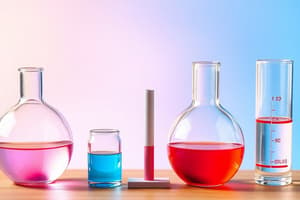Podcast
Questions and Answers
What is the definition of chemical equilibrium?
What is the definition of chemical equilibrium?
Chemical equilibrium is the point at which the rate of the forward reaction equals the rate of the reverse reaction.
Does a chemical actually stop once equilibrium is reached?
Does a chemical actually stop once equilibrium is reached?
False (B)
Which reaction will make more products, Reaction A with an equilibrium constant of 1213 M or Reaction B with 0.344 M²?
Which reaction will make more products, Reaction A with an equilibrium constant of 1213 M or Reaction B with 0.344 M²?
The first one will make more products.
What is wrong with the student's statement regarding single and double arrows in chemical reactions?
What is wrong with the student's statement regarding single and double arrows in chemical reactions?
Why do we ignore solids in the equilibrium constant when using Le Chatelier's principle?
Why do we ignore solids in the equilibrium constant when using Le Chatelier's principle?
Why are acid ionization reactions important in chemistry?
Why are acid ionization reactions important in chemistry?
What is the range of the pH scale?
What is the range of the pH scale?
Which is (are) the acidic solution(s) among the following: Solution A (pH = 1), Solution B (pH = 10), Solution C (pH = 7)?
Which is (are) the acidic solution(s) among the following: Solution A (pH = 1), Solution B (pH = 10), Solution C (pH = 7)?
Which solution is made with the acid that has the lowest ionization constant among: Solution A (pH = 1), Solution B (pH = 4), Solution C (pH = 6)?
Which solution is made with the acid that has the lowest ionization constant among: Solution A (pH = 1), Solution B (pH = 4), Solution C (pH = 6)?
Where does acid rain come from?
Where does acid rain come from?
Flashcards are hidden until you start studying
Study Notes
Chemical Equilibrium
- Chemical equilibrium occurs when the forward reaction rate equals the reverse reaction rate.
- Reactions do not stop at equilibrium; they continue to occur in both directions.
Reaction Equilibrium Constants
- Reaction A has an equilibrium constant of 1213 M, indicating it favors product formation.
- Reaction B has an equilibrium constant of 0.344 M², suggesting it produces fewer products compared to Reaction A.
Misconceptions About Reactions
- All chemical reactions are in equilibrium; misconceptions stem from how reactions are represented (single vs. double arrows).
- A single direction arrow indicates that reactions produce negligible reactants at equilibrium, but equilibrium still exists.
Solids in Equilibrium Constant
- Solids are excluded from equilibrium constant calculations because their concentrations remain unchanged during reactions.
Acid Ionization Reactions
- Acid ionization reactions are crucial for determining the strength of acids in chemistry.
pH Scale
- The pH scale spans from 0 (highly acidic) to 14 (highly basic), with 7 being neutral.
Acidic Solutions
- Among the provided solutions, Solution A (pH = 1) is classified as acidic.
Ionization Constants of Acids
- In a comparison of three acid solutions by pH level, Solution C (pH = 6) has the lowest ionization constant, indicating it is the weakest acid.
Origin of Acid Rain
- Acid rain results from pollutants like sulfur trioxide and nitrogen dioxide reacting with water, forming acidic compounds.
Studying That Suits You
Use AI to generate personalized quizzes and flashcards to suit your learning preferences.




